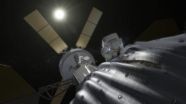(Press-News.org) Surrounding the sun is a vast atmosphere of solar particles, through which magnetic fields swarm, solar flares erupt, and gigantic columns of material rise, fall and jostle each other around. Now, using NASA's Solar Terrestrial Relations Observatory, scientists have found that this atmosphere, called the corona, is even larger than thought, extending out some 5 million miles above the sun's surface -- the equivalent of 12 solar radii. This information has implications for NASA's upcoming Solar Probe Plus mission, due to launch in 2018 and go closer to the sun than any man-made technology ever has before.
These STEREO observations provide the first direct measurements of the inner boundary of the heliosphere -- the giant bubble sparsely filled with solar particles that surrounds the sun and all the planets. Combined with measurements from Voyager 1 of the outer boundary of the heliosphere, we have now defined the extent of this entire local bubble.
"We've tracked sound-like waves through the outer corona and used these to map the atmosphere," said Craig DeForest of the Southwest Research Institute in Boulder, Colorado. "We can't hear the sounds directly through the vacuum of space, but with careful analysis we can see them rippling through the corona."
The results were published in The Astrophysical Journal on May 12, 2014. The researchers studied waves known as magnetosonic waves, and they are a hybrid of sound waves and magnetic waves called Alfven waves. Unlike sound waves on Earth, which oscillate several hundred times per second, these waves oscillate about once every four hours -- and are about 10 times the length of Earth.
Tracking magnetosonic waves showed DeForest and his team that the material throughout this extended space remained connected to the solar material much further in. That is to say that even out to 5 million miles from the sun, giant solar storms or coronal mass ejections can create ripple effects felt through the corona. Beyond that boundary, however, solar material streams away in a steady flow called the solar wind -- out there, the material has separated from the star and its movement can't affect the corona.
Realizing that the corona extends much further than previously thought has important consequences for NASA's Solar Probe Plus because the mission will travel to within 4 million miles of the sun. Scientists knew the mission would be gathering information closer to the sun than ever before, but couldn't be sure it would travel through the corona proper.
"This research provides confidence that Solar Probe Plus, as designed, will be exploring the inner solar magnetic system," said Marco Velli, a Solar Probe Plus scientist at NASA's Jet Propulsion Laboratory in Pasadena, California. "The mission will directly measure the density, velocity and magnetic field of the solar material there, allowing us to understand how motion and heat in the corona and solar wind are generated."
With direct access to the sun's atmosphere, Solar Probe Plus will provide unprecedented information on how the solar corona is heated and revolutionize our knowledge of the origin and evolution of the solar wind.
INFORMATION:
NASA's STEREO maps much larger solar atmosphere than previously observed
2014-06-25
ELSE PRESS RELEASES FROM THIS DATE:
New NASA model gives glimpse into the invisible world of electric asteroids
2014-06-25
Space may appear empty -- a soundless vacuum, but it's not an absolute void. It flows with electric activity that is not visible to our eyes. NASA is developing plans to send humans to an asteroid, and wants to know more about the electrical environment explorers will encounter there.
A solar wind blown from the surface of the sun at about a million miles per hour flows around all solar system objects, forming swirling eddies and vortices in its wake. Magnetic fields carried by the solar wind warp, twist, and snap as they slam into the magnetic fields around other objects ...
Carbon-fiber epoxy honeycombs mimic the material performance of balsa wood
2014-06-25
Cambridge, Mass. – June 25, 2014 – In wind farms across North America and Europe, sleek turbines equipped with state-of-the-art technology convert wind energy into electric power. But tucked inside the blades of these feats of modern engineering is a decidedly low-tech core material: balsa wood.
Like other manufactured products that use sandwich panel construction to achieve a combination of light weight and strength, turbine blades contain carefully arrayed strips of balsa wood from Ecuador, which provides 95 percent of the world's supply.
For centuries, the fast-growing ...
Changes in forage fish abundance alter Atlantic cod distribution, affect fishery success
2014-06-25
A shift in the prey available to Atlantic cod in the Gulf of Maine that began nearly a decade ago contributed to the controversy that surrounded the 2011 assessment for this stock. A recent study of how this occurred may help fishery managers, scientists, and the industry understand and resolve apparent conflicts between assessment results and the experiences of the fishing industry.
When the dominant prey species of Atlantic cod changed from Atlantic herring to sand lance beginning in 2006, cod began to concentrate in a small area on Stellwagen Bank where they were easily ...
New insights for coping with personality changes in acquired brain injury
2014-06-25
Amsterdam, NL, June 25, 2014 – Individuals with brain injury and their families often struggle to accept the associated personality changes. The behavior of individuals with acquired brain injury (ABI) is typically associated with problems such as aggression, agitation, non-compliance, and depression. Treatment goals often focus on changing the individual's behavior, frequently using consequence-based procedures or medication. In the current issue of NeuroRehabilitation leading researchers challenge this approach and recommend moving emphasis from dysfunction to competence. ...
People with tinnitus process emotions differently from their peers, researchers report
2014-06-25
CHAMPAIGN, Ill. — Patients with persistent ringing in the ears – a condition known as tinnitus – process emotions differently in the brain from those with normal hearing, researchers report in the journal Brain Research.
Tinnitus afflicts 50 million people in the United States, according to the American Tinnitus Association, and causes those with the condition to hear noises that aren't really there. These phantom sounds are not speech, but rather whooshing noises, train whistles, cricket noises or whines. Their severity often varies day to day.
University of Illinois ...
New math technique improves atomic property predictions to historic accuracy
2014-06-25
By combining advanced mathematics with high-performance computing, scientists at the National Institute of Standards and Technology (NIST) and Indiana University (IU) have developed a tool that allowed them to calculate a fundamental property of most atoms on the periodic table to historic accuracy—reducing error by a factor of a thousand in many cases. The technique also could be used to determine a host of other atomic properties important in fields like nuclear medicine and astrophysics.*
NIST's James Sims and IU's Stanley Hagstrom have calculated the base energy levels ...
Study: Motivational interviewing helps reduce home secondhand smoke exposure
2014-06-25
A Johns Hopkins-led research team has found that motivational interviewing, along with standard education and awareness programs, significantly reduced secondhand smoke exposure among children living in those households.
Motivational interviewing, a counseling strategy that gained popularity in the treatment of alcoholics, uses a patient-centered counseling approach to help motivate people to change behaviors. Experts say it stands in contrast to externally driven tactics, instead favoring to work with patients by acknowledging how difficult change is and by helping people ...
MicroRNA that blocks bone destruction could offer new therapeutic target for osteoporosis
2014-06-25
DALLAS – June 25, 2014 – UT Southwestern cancer researchers have identified a promising molecule that blocks bone destruction and, therefore, could provide a potential therapeutic target for osteoporosis and bone metastases of cancer.
The molecule, miR-34a, belongs to a family of small molecules called microRNAs (miRNAs) that serve as brakes to help regulate how much of a protein is made, which in turn, determines how cells respond.
UT Southwestern researchers found that mice with higher than normal levels of miR-34a had increased bone mass and reduced bone breakdown. ...
First positive results toward a therapeutic vaccine against brain cancer
2014-06-25
Astrocytomas and oligodendrogliomas are subtypes of a brain cancer called 'glioma'. These incurable brain tumors arise from glial cells, a type of support cell found in the central nervous system. "Low-grade gliomas", which grow comparatively slowly, spread in a diffuse manner across the brain and are very difficult to completely eliminate through surgery. In many cases, the effectiveness of treatments with chemotherapy and radiotherapy is very limited. Gliomas can develop into extremely aggressive glioblastomas.
Low-grade gliomas have a particular feature in common: ...
Natural resources worth more than US$40 trillion must be accounted for
2014-06-25
Natural resources worth more than US$40 Trillion must be accounted for
Governments and companies must do more to account for their impact and dependence on the natural environment - according to researchers at the University of East Anglia.
New research published today in the journal Nature Climate Change reveals that although some companies like Puma and Gucci are leading the way, more needs to be done to foster a sustainable green economy.
Researchers say that while the economic value of lost natural resources can be difficult to quantify, much more must be done ...




